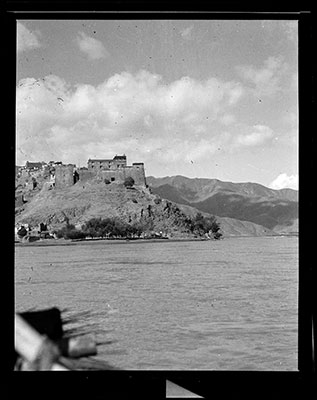
2001.59.4.1.1 (Film negative)


2001.59.4.1.1 (Film negative)

Hugh E. Richardson
Hugh Richardson
1950
Tsangpo Valley Region > Gongdkar dzong
2001.59.4.1.1
54 X 43 mm
Negative film nitrate
Donated August 2001
The executors of the estate of Hugh E. Richardson
Hugh E. Richardson
HR Album 4.1
Manual Catalogues - Notes on negative album - '4 LHOBRAG 1950' 'Gongkar. Dzaring La. Lha khang Dzong. Sras. Pemaling Tso. Ku la kangri.' written in white in Richardson's hand.
Manual Catalogues - Notes in negative index '3' - Folio 1. 'GONGKHAR DZONG'
Manual Catalogues - Richardson's Handlist. 'Album 4. Journey starting at Gong dkar rdzong on Gstang-po, 29.18 N. 90.48 E. [no.] 1. Gong-dkar rdzong
Research publication - A cropped version of this image appears in High Peaks, Pure Earth , H. E. Richardson, London, Serindia Publications, 1998, plate 62.
Other Information - Gong Khar is located on the banks of Tsangpo (Brahmaputra) and the fort used to be powerful centre for Sakya rulers until the 19th Century. (TS)
Other Information - Dates: The date of 1950 for this image is derived from Richardson’s negative album No.4, the cover of which is marked with ‘Lhobrag 1950’. There are 16 images, of Chidesho, Gongkhar Dzong, Lhasa Post Office, Nesar, Yamdrok Tso and Shabsha, Karmaling Chu, Lhobrag, which share the same batch development number and seem to relate to a trip that Richardson took in this year. His preference for using 6x4.5 images, the smallest exposure size possible using his Zeiss Super Ikonta camera, seems to have returned only towards the end of his time in Tibet, possibly to maximise the number of images that he could take on each roll of film (16 using a film plane mask of this size or 8 at 6x9 cm) and this also suggests that the image was taken at the end rather than the beginning of his residence in Tibet [MS 17/12/2005]
For Citation use:
The Tibet Album.
"Fortress of Gongkhar Dzong with river flowing in front"
05 Dec. 2006. The Pitt Rivers Museum.
<http://tibet.prm.ox.ac.uk/photo_2001.59.4.1.1.html>.
For more information about photographic usage or to order prints, please visit the The Pitt Rivers Museum.
© The Pitt Rivers Museum